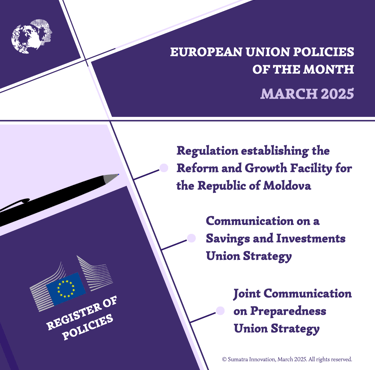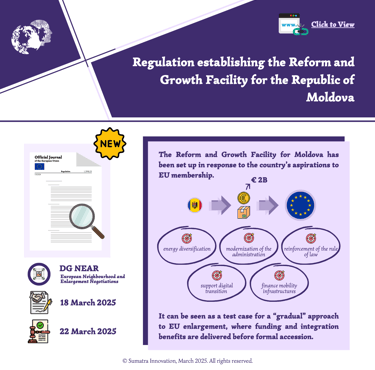Register of Policies / March 2025



1/ Regulation establishing the Reform and Growth Facility for the Republic of Moldova
In response to Moldova's aspirations to EU membership, the Reform and Growth Facility has been set up for the Republic of Moldova. It will serve as a geopolitical instrument to stabilize and anchor Moldova in the EU's political and economic orbit, by strengthening the country's resilience through structural reforms, energy diversification, modernization of the administration and reinforcement of the rule of law. Around €2 billion will be allocated, including €1.5 billion in the form of highly concessional loans with maturities of up to 40 years and repayments starting after 2034. Other key investment areas include digital transition based on the EU's digital compass and 5G toolkit, public administration reforms, and connectivity and infrastructure such as cross-border links with the EU or TEN-T integration. Moldova can be seen as a test case for a “gradual” approach to EU enlargement, where significant benefits in terms of funding and integration are delivered before formal accession.
EU law: Communication (2025)/124
2/ Communication on a Savings and Investments Union Strategy
The EU-27 faces critical economic hurdles, such as the convergence of macroeconomic, geopolitical and regulatory challenges. With the Communication on the Savings and Investment Union Strategy, the Commission presents its vision to unlock private capital, modernize EU financial markets and boost the competitiveness of the economy in the face of urgent investment needs (EUR 750 to 800 billion per year according to Mario Draghi). Indeed, the EU lags behind the US and China in financing high-growth sectors such as clean technology, digital and defense, and SMEs in the EU struggle to access equity. Although households in the EU save a lot (around EUR 10 trillion in bank deposits), these savings are not efficiently mobilized for product investments that benefit the Union. The aim is therefore to bridge the gap between the high savings rate in Europe and the underinvestment in key sectors. Strategic objectives include unlocking retail savings (e.g., promoting supplementary pensions and auto-enrolment in all Member States, introducing an EU-wide savings and investment account with tax incentives), improving market integration and scale, and mobilizing investment and financing (e.g. removing the tax disadvantage of debt versus equity via DEBRA and FASTER, improving investment exit mechanisms, expanding access to venture capital and growth capital for SMEs). Implementation will take place in waves of legislative and non-legislative measures in 2025 and 2026, followed by a mid-term review in mid-2027.
EU law: Regulation (EU) 2025/535
3/ Joint Communication on Preparedness Union Strategy
In an era of polycrisis (geo-economic tensions, climate disasters, hybrid threats, war in Ukraine), the Preparedness Union strategy was developed, recognizing the EU's reactive rather than proactive approach. Over time, despite the ERCC (Emergency Response Coordination Centre), rescEU and Strategic Compass initiatives, no comprehensive “Union of Preparedness” has ever been created, reflecting the absence of a unified, forward-looking risk governance architecture within the EU. As a result, and as outlined in the Niinistö report, the strategy incorporates three fundamental principles: an all-hazards approach (natural, technological, health, cyber and hybrid threats), whole-of-government coordination (local, national and European levels) and whole-of-society engagement (citizens, civil society and the private sector). It defines 30 concrete actions, organized around 7 pillars: foresight and anticipation (1), resilience of vital societal functions (2), population preparedness (3), public-private cooperation (4), civil-military cooperation (5), crisis response (6) and resilience through external partnerships (7).
EU law: Joint Communication (2025)/130







